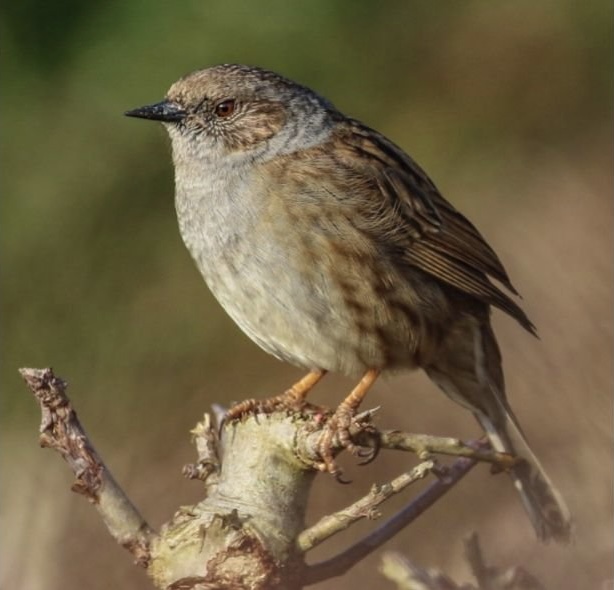People often wonder whether they’re seeing the same dunnocks in their garden year after year, and how long it takes for a dunnock to transition from a dunnock egg into a fully-fledged adult dunnock. Let’s read on to find out.
A dunnock (scientific name prunella modularis) is a small bird commonly found in gardens, parks and woodland up and down the UK. Dunnocks have a small wingspan of up to 21cm, and adult dunnocks grow up to 14cm in length.
Dunnocks look very similar to sparrows, with only their head markings and beak shape used to tell them apart. Despite being commonly mistaken for belonging to the sparrow family, dunnocks (or ‘hedge sparrows’) belong to the accentor family of birds.
Their head markings are different to those of a sparrow, being more blue-grey than brown. Their beaks are sharp rather than the rounded beak of a sparrow, which enables them to feed more easily on insects and worms. Dunnocks often feed on the ground, and can often be seen darting around on grass and under garden shrubbery.
Dunnocks eat a diet of both plants and animals. Their main source of food consists of different types of invertebrates, most commonly spiders, snails, worms and insects. They mainly stick to eating animals, and have even been seen to eat small birds and mice on occasion.
They do sometimes eat plants too, especially in the winter months when food is harder to come by. Their sharp, pointed beaks are ideally suited to pulling grubs and worms out of long grass, rather than cracking open seeds, which would be easier with a rounded beak, like that of a sparrow.
The Life Cycle Of A Dunnock
- Dunnock Egg: A dunnock egg is typically 19mm long, and is glossy in appearance. A dunnock egg is typically incubated for 12 to 13 days before hatching into nestlings.
- Dunnock Nestlings: A nestling is the name given to a baby bird when it has hatched, and while it is still heavily depended on adult birds to feed it. Nestling hedge sparrows are often in the early stages of growing feathers, and are a light brown colour. Dunnock nestlings will most likely have their eyes open at this stage, but will rely heavily on their parents for security and food. Dunnocks will be in the nestling stage for between 11 and 12 days before transitioning into the fledgling phase.
- Dunnock Fledglings: The fledgling phase of a dunnock’s life describes the transition from a young dunnock into an adult dunnock. Fledgling hedge sparrows usually leave the nest when it becomes too crowded due to the size of the young birds, and when the parent birds are ready to have a new brood. Fledgling dunnocks more closely resemble their parents than nestlings, and will have most of their adult feathers. Dunnocks will stay close by to the nest even once they have left it, and usually spend this time practicing flying and feeding on their own. This is the period of time in which a young dunnock does most of its learning; fledgling dunnocks will observe their parents over a period of days or weeks before becoming fully independent.
- Juvenile Dunnocks: Juvenile hedge sparrows are generally independent from their parents, although they may stay near them and approach them for food if it is scarce. Juvenile dunnocks are very similar in appearance to adult dunnocks. Their grey-blue head and brown body distinguish them from other garden birds.
- Hedge Sparrows & Breeding: Once dunnocks have reached maturity at about a year old, they will begin to breed. Dunnocks breed differently to a lot of other garden birds, because they are polyandrous. This means that one female will often mate with several male dunnocks during one breeding season. This increases the chances that a male will be available to help the female look after her dunnock egg brood. More males mean more help on hand to feed the nestlings! Not only do females mate with multiple males during a season, but they often all raise the brood together too. Nestlings within a brood of hedge sparrows can have different fathers, meaning there are often multiple males on hand to care for the chicks. A brood of dunnock nestlings can be raised by a single female, multiple females with the full-time or part-time help of a male, or by multiple females and multiple males. When multiple male hedge sparrows are involved in the care of a brood with a female, there is usually an alpha male who provides more care than a beta male. However, if no female is present to care for the young birds, then the alpha and beta males will care for the nestlings in equal proportions.
A study of dunnock breeding patterns found that male hedge sparrows do not discriminate between their own young and the young of other males in the same brood.
Dunnocks typically live for two years, but can live for longer than this in areas where their predators are few and far between. The record for the oldest dunnock known is 11 years and three months!

